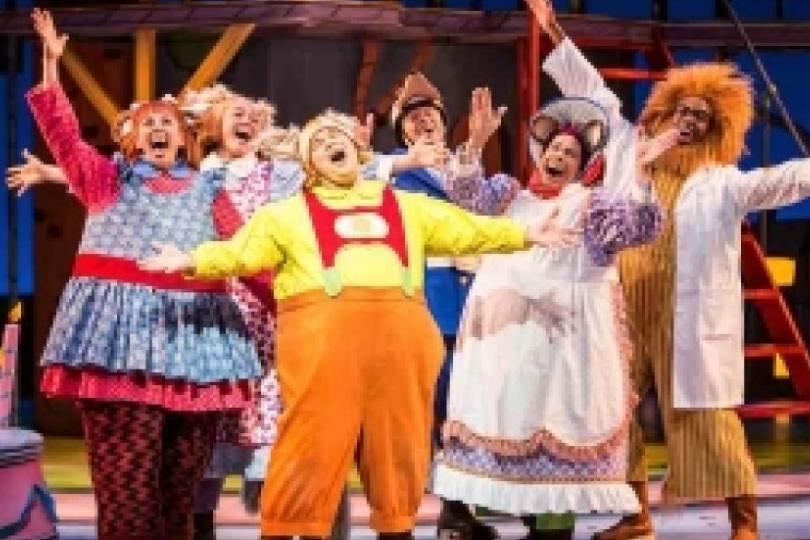As both a child owner and an English major, I read a lot of children’s literature. I also see a lot of adaptations of children’s literature, both on film and on stage. Sometimes the original text leads us into the adaptation, sometimes the other way around – my son was briefly obsessed with
The Jungle Book after we saw Top Hat Theatre’s production at this year’s Fringe Festival, but quickly lost interest when we tried wading into Rudyard Kipling’s comparatively burdensome prose.
From a writer’s perspective, I’m always fascinated at how playwrights and screenwriters approach children’s material. In a case like
The Jungle Book at Fringe, it entailed trimming Kipling’s lengthy narrative down to its vitals and trading in some of the deeper characterization for striking visuals and a rapid pace that kept the kids interested and abided by the fest’s 60-minute time limit. For something like
Cloudy with a Chance of Meatballs, one of my favorite recent kids’ movies, it meant fleshing out the original book's thin concept and developing a cast of characters and narrative arc that bear only the faintest resemblance to the source material. And of course in the case of Disney it usually means eviscerating any public domain property that can be retrofitted with funny animals and a happy ending. (When my son makes up a game that veers radically from the source material, he says we’re playing “the Disney version.”)
And so I was intrigued at the prospect of the Children’s Theatre’s presentation of
Busytown: The Musical, an adaptation of Richard Scarry’s massive body of work, particularly his masterpiece
What Do People Do All Day? Like a lot of Scarry’s best books, that one is virtually plotless, more concerned with showing the step-by-step processes of occupations ranging from highway construction to postal delivery to agricultural sales.
Entertaining technical manuals
I’ve long marveled that Scarry was able to craft children’s books that verged on being beginner’s technical manuals yet remained engrossing and eminently re-readable. It seemed unlikely that a stage production would, or even should, attempt to faithfully adapt that ineffable balance. I went into
Busytown expecting something along the lines of either
You’re a Good Man, Charlie Brown - recitations of recognizable bits from the source material leavened by unnecessary songs and shrill characterizations – or one of the more narrative-driven Scarry adaptations that have played the kids’ TV circuit over the years. (Don't get me wrong, I dig
Busytown Mysteries as much as the next dad, but I'm not itching to see its formula played out on stage.)
What I got instead was something of a marvel – a faithful adaptation that captured the spirit of the original book and worked as both children’s theater and a musical. Kevin Kling’s script pays due reverence to Scarry’s dogged depictions of the grinding gears of daily life, whisking Huckle Cat, Betsy Bear, Lowly Worm and their compatriots from set piece to set piece with a manic energy befitting a famously busy, busy town. Buoyed by a rousing – if not especially ear-wormy - roster of original songs (with Music by Michael Koerner and lyrics by Kling and Koerner). and Eric J. Van Wyk’s cleverly adaptable set design, Kling captures Scarry’s gift for conveying step-by-step procedures without coming off like an industrial training film. There are a few nods to conventional narrative, most notably a through-story about Betsy Bear mailing a party invitation to her grandma, but for the most part Kling abides by Scarry’s formula of short, self-contained scenes linked only by a few constant characters and a burning need to answer the question of “What do people do all day?”
All of it works, and I’m not sure how, ironic for a play all about how things work. Kling isn't retelling a timeless story - it's hardly a story at all. Scarry's barely developed characters are more iconic than beloved, and the play isn't interested in remedying that. And truth be told, the inner workings of the local bakery and doctor's office lose a little bit of resonance in the translation from page to stage.
A milder form of mania
But
Busytown: The Musical still works, largely because the production manages to harness the manic yet meticulous energy of Scarry's books. It's a trickier thing to pull off than, say, last year's massively entertaining
If You Give a Mouse a Cookie. Whereas that production allowed pure anarchic destruction to carry much of the load,
Busytown requires a milder form of mania. Some of that comes directly from Scarry - a slapstick rescue by a bumbling fire brigade, a steady stream of automobiles shaped like foods and household objects - and some of it is the work of Kling and director Sean Graney - Autumn Ness's gleefully demented nonsequiturs as Betsy Bear, Dean Holt giving a masterful physical performance as Lowly Worm even with only his head visible to the audience.
It feels like a cop-out to chalk a show's success up to the intangibles, but I'm not sure how else to put it when talking about a production where capturing the right vibe is more important than re-creating the substance. The bottom line is that
Busytown: The Musical worked for me as a fan of the source material. As for my son, he also liked the show a lot and had plenty to say about it afterward (he has some interesting conspiracy theories about the whereabouts of Bananas Gorilla), but I did note that he didn't dig out his old Richard Scarry books when he got home. Instead, he's now more focused on preparing for the Children's Theatre's summer production of
20,000 Leagues Under the Sea. I reckon we have some reading ahead of us.





